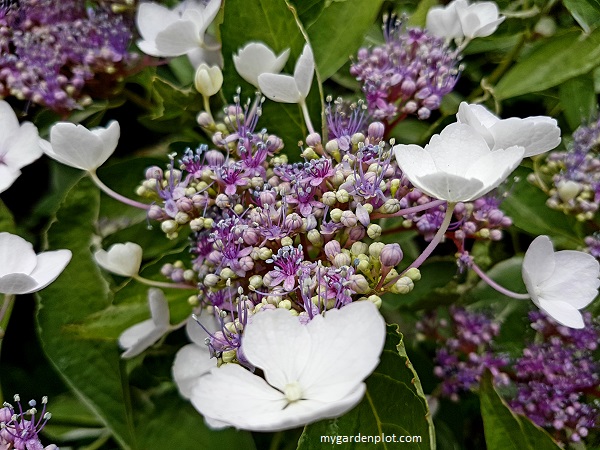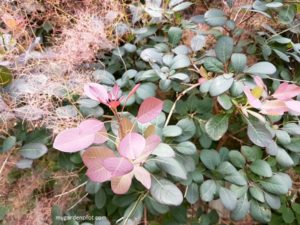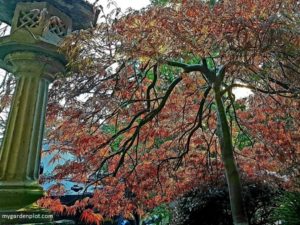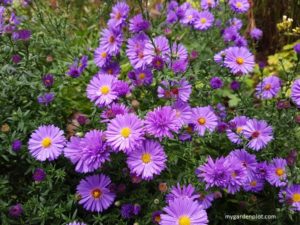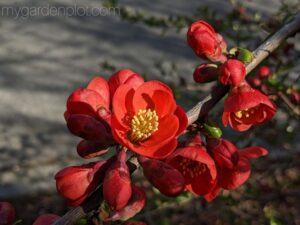Where To Plant, How To Grow And When To Prune Hydrangeas
Hydrangeas are native to Eastern Asia, South and North America. Although none of the species come from the Pacific Northwest, the region is perfect for hydrangeas as they thrive here. The exception are those hydrangea species that need an extended, consistent hot summer. But for many hydrangeas, a cooler summer is their preference. They are also reliably winter hardy. Hydrangeas are easy-care shrubs and climbers that come in a variety of sizes and flower choices. Learn where to plant and how to grow hydrangeas.
Like with so many gardeners around the world, growing hydrangeas are popular, adding nostalgic charm in a garden. Their lush foliage and profusion of large flowers add interest that lasts from mid-summer through to autumn. They are suitable for mixed borders, woodland gardens, and the smaller varieties look enchanting in container gardening.
Needless to say, the flowerheads make excellent cut flowers and are beautiful in fresh bouquets. The mophead is particularly lovely dried too. Knowing where to plant and how to care for hydrangeas, and understanding all the terminology that comes with this plant can sometimes seem daunting. But it doesn’t need to be. Below we provide an overview of the hydrangea flower, and the main types you will find at your garden centre. Along with tips on growing and pruning your hydrangea.
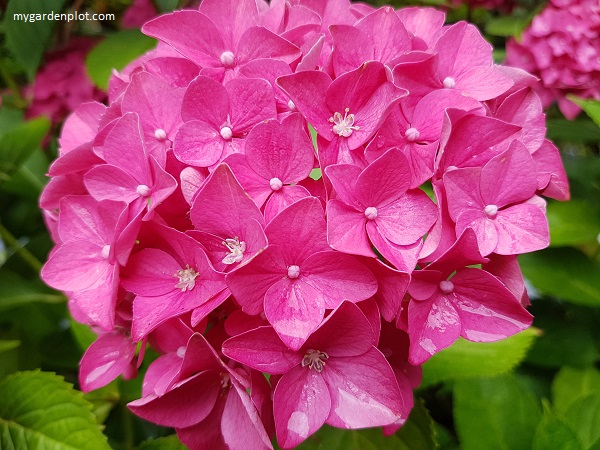
About The Hydrangea Flowerhead
If you are new to hydrangeas, it may seem that the flowers come with many descriptions and differences.
The flowerheads are either round, flat or conical (or panicle) in shape. These vary in size depending on the species and variety.
The hydrangea has two types of flowers, a fertile flower and a sterile flower. The fertile flower is tiny and somewhat insignificant, unless you look closely – it is beautiful in its own right. The sterile flower, known as ray floret, has three to five coloured papery sepals. Similar to the showy clematis sepals, the ray florets compose the overall draw that attracts pollinators to fertile flowers.
We then have ‘lace-cap’ or ‘lacecap’ and ‘mophead’ descriptions that relate to the flower arrangement. The delicate-looking lacecap has a flat appearance, comprised of a large number of small fertile flowers
bordered by a few ray florets (sterile flowers). The rounded mophead is composed mostly of ray florets. Amd the conical flowerhead consists entirely of ray florets or just fertile flowers, or a mix of the two.
A note about hydrangeas, it can take a young plant two to five years to flower. So don’t despair if your new plant is younger than you thought and does not flower the first year you plant it.
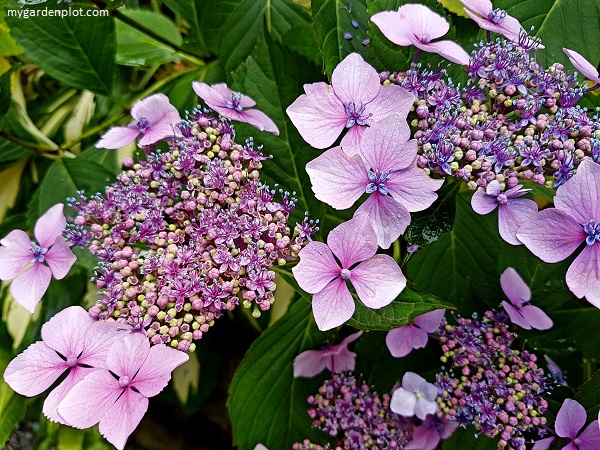
Hydrangeas At A Glance
Type: Deciduous (exception is the evergreen climbing H. serratifolia)
Location: Varies – full sun to part shade
Blooming Season: Summer
Size: Varies – small container size plants to 6 metres (20 feet)
When To Prune: After Flowering / Late Winter / Early Spring (see pruning details below)
Where To Plant And How To Care For Hydrangeas
Hydrangeas thrive in moist, well-drained soil. They are versatile and can thrive in either acidic, neutral or slightly alkaline soil. Note that extremely alkaline soils can cause chlorosis. Add compost or bone meal to the soil when planting. New plants should be planted in spring.
Some hydrangea types thrive in full sun while others need a part shady spot sheltered from the hot afternoon sun in summer or excessive windy location. The rule of thumb is that most hydrangeas need somewhere between three to six hours of direct sun, preferably morning sun. Smaller shrub varieties do well in containers too.
They are not drought-tolerant, and need regular watering.
Fertilize in spring by applying humus-rich compost or a slow-release organic balanced fertilizer once a year.
Hydrangea Flower Colour Changes
Hydrangeas can tolerate pH soil levels of either acidic, neutral or slightly alkaline soil. However, the flowerheads react when planted in high acidic soil by turning a beautiful blue colour. The same shrub will change to pink when planted in less acidic or neutral soils.
How To Prune Hydrangeas
Any pruning required for a hydrangea is determined by whether it flowers on old wood or new wood.
- Hydrangeas that bloom on old wood only needs a minimum amount of pruning, which should be done as soon as possible after flowering.
- Hydrangeas that bloom on new wood should be pruned about one-third of the old stems in late winter or early springtime.
With any routine pruning cutting back to healthy buds improves flower quality and helps develop a balanced growth form. Always prune winter dieback and remove any weak or damaged stems by early spring. Also, look for any stems that are rubbing or crossing over each other. If the hydrangea plant suffers and seems utterly dead after a severely cold winter or unexpected freezing in spring, treat the entire plant as winter dieback and prune down to the ground. In all likelihood, it will spring back (pun intended!), and you should start seeing new growth.
Should a neglected or mature hydrangea shrub become too woody or overcrowded, hydrangeas can tolerate a hard prune down to about 15 cm (6 inches) from the ground by late winter or early spring. Note that this type of remedial hard pruning means a loss of flowers for the next flowering season.
Continue reading below about each hydrangea type and further tips on how to care and prune them.
RELATED TOPIC: Buyer’s Guide On How To Choose Hand Pruners (Secateurs)
RELATED TOPIC: Buyer’s Guide On How To Choose A Pruning Saw
Hydrangea Types And Growing Tips
Hydrangeas fall into six deciduous types, plus the evergreen climber. There are many varieties and cultivars developed from these six species. Knowing which type you have will help pinpoint how best to care and prune the hydrangea in your garden. If in doubt what type of hydrangea plant you have, don’t prune it yet so that you see how it develops.
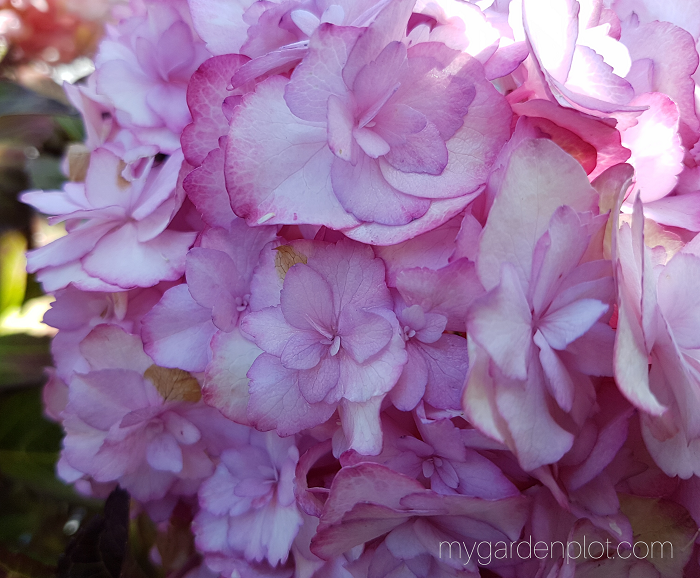
Hydrangea macrophylla (Bigleaf or French Hydrangea)
The H. macrophylla (Bigleaf or French hydrangea) is one of the most well-known hydrangeas from which many of the most popular cultivars have been developed. Sometimes H. macrophylla mophead is referred to by its older name, Hortensia. Native to Japan, this species is prevalent in Pacific Northwest gardens. Generally, round in growth habit, and depending on the cultivar, have either mopheads and lacecaps flowerheads in pink, purple or blue. Easy to grow, reliable and can tolerate harsher locations with wind and sea spray. The mopheads can have rather large handsome flowerheads and are enhanced against dark green foliage. Flowerheads grow from old wood, which means it sets its flowers on old wood. The Bigleaf Hydrangea seldom needs extensive pruning. Any deadheading needs to be done carefully to not sacrifice flowering the following year. If remedial pruning is required, it is best done late summer immediately after flowering. There are now some new H. macrophylla cultivars that bloom on new growth or on both new and old wood. Do check the details provided in the garden centre when selecting a new cultivar plant. Zones 6 – 9.
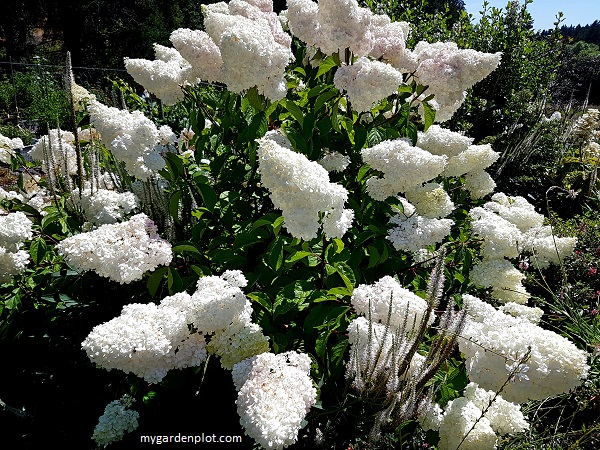
Hydrangea paniculata (Panicle Hydrangea)
The H. paniculata (Panicle Hydrangea) is an upright shrub with conical, white flowerheads, native to China and Japan. These have both fertile and sterile flowers and bloom from mid-summer through to early autumn. They are cold hardy and can tolerate most soil types, including chalky or sandy. Panicle Hydrangea is reliable and blooms on new wood. In late winter or early spring prune the Panicle Hydrangea back by a half or about 30-60 cm (12-24 inches) from the ground. Zone 3 – 9.
The ‘Grandiflora’ (or Pee Gee Hydrangea) is a classic hydrangea growing as tall as 7.5 metres (20 feet) with large conical flowers measuring up to 45 cm (18 inches). The ‘Grandiflora’ is an impressively large shrub that can be pruned to form a vase-shaped form or trained as a single stem ‘tree’ with flowers on the top. Our absolute favourite is H. paniculate ‘Limelight’. The lime-green flowerheads transform into white before turning pink in autumn. It thrives in full sun and can tolerate part shade.
Hydrangea serrata (Mountain Hydrangea)
Similar to the H. macrophylla (Bigleaf or French hydrangea), the H. serrata (Mountain hydrangea) flower buds form on old wood but are more cold hardier than the Bigleaf. It is native to Japan and Korea. They have mophead and lace-cap type flowerheads and come in shades of pink, blue or white. They tend to be smaller than the Bigleaf cousin, and most cultivars are suitable for container gardening and smaller gardens. They thrive in partial shade, preferably with some morning sun. The same care and pruning as Bigleaf Hydrangea should be applied to the Mountain hydrangea. Zones 5 – 9.
Hydrangea arborescens (Smooth Hydrangea)
The H. arborescens (Smooth Hydrangea) is native to eastern USA. It has large, showy flowerheads. The ‘Annabelle’ cultivar has flowerheads that can be as wide as 30 cm (12 inches). Smooth hydrangeas are hardy shrubs with a rounded habit and a height of 1.8 metres (6 feet). This hydrangea type prefers a partly shaded location where it is protected from hot afternoon sun during summer. Smooth Hydrangeas bloom on new wood. It can be pruned back hard to one-third or about 30 cm (12 inches) from the ground to encourage blooms, and this helps maintain their size. Prune in late winter to early spring. The Smooth Hydrangea is native to Eastern North America. Suitable for zones 3 – 9.
Hydrangea quercifolia (Oakleaf Hydrangea)
The H. quercifolia (Oakleaf Hydrangea) has similar cone-shaped blooms as the H. paniculate (Panicle Hydrangea). It has a distinctive oakleaf shape, hence the name, and can grow to a height of 2.5 metres (8 feet). Generally, needs long, consistently hot summers and prefers partial shade. Where summer months are shorter, it thrives best in full sun. Oakleaf Hydrangea blooms on old wood and only needs a little pruning. Any pruning should be done soon after the flowers fade. Native to the southeastern USA. Zone 5 – 9.
Hydrangea anomala ssp. petiolaris (Deciduous Climbing Hydrangea)
The H. anomala ssp. petiolaris (Climbing Hydrangea) is an elegant, fragrant climber that is shade tolerant and can brighten a shady fence or wall. However, it needs a little direct sun to boost its lace-cap white flowerheads. It is native to Japan and Korea. The climbing hydrangea blooms on new wood. With its aerial roots, it can easily cling on any rough surface and can easily grow up trees. It is a hardy climber and can grow 25 metres (80 feet). It is slow-growing until roots are established. Blooms earlier than the other hydrangea types in June and July. Climbing Hydrangeas require little to no pruning unless you need to control the plant growth. Any light pruning should be done in late summer after flowering or in early spring if necessary. The evergreen climbing hydrangeas benefit from removing the stem tip to encourage dense branching. Remove hanging stems. This climber does not always respond well to rejuvenating. If necessary, remedial pruning top-heavy climbing hydrangeas should be phased over two or three years rather than a hard prune in one session. Zone 5 – 9.
Hydrangea serratifolia (Evergreen Climbing Hydrangea)
The H. serratifolia (Evergreen Climbing Hydrangea) is a slow-growing and low maintenance climber. It is native to Argentina and Chile. The off-white clusters of fertile flowers bloomsg from mid to late summer. This evergreen hydrangea climber is hardy and thrives in moisture-retentive soil. It is self-clinging and can grow 4.5 metres (15 feet). As a vine, it thrives best on a wall or tree support. It is best positioned in a sheltered but part sunny site. Any pruning needed should be done after flowering. Zones 6 – 9.
If you are looking for a fast-growing hardy evergreen climber, check out: Evergreen Armand Clematis
Pests and Diseases
Hydrangeas, unfortunately, are not deer resistant and can be occasionally troubled by aphids or slugs, which is easy to resolve. They can also sometimes be affected by rust, powdery mildew, and leaf spot.
RELATED TOPICS:

